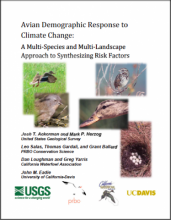Avian Demographic Response to Climate Change: A Multi-Species and Multi-Landscape Approach to Synthesizing Risk Factors

Management actions can directly affect the demography of bird populations, such as nest survival. Understanding the biophysical effects on avian demographics provides a sound foundation for natural resource management, including more robust predictions of future species distributions and species population viability.
This report summarizes research on the expected variation in avian demographic responses to environmental change for several species across a gradient landscapes from the San Francisco Bay to the Central Valley of California. We used two avian taxa, waterfowl and songbirds, as case studies for the integration of long-term demographic data with climate change variables. For each taxon, we assessed and synthesized several demographic responses to climate change variables (i.e., precipitation and temperature).
A web-based application was created to provide assess to the results of this study; see http://climate.calcommons.org/web/avian-demographic-response-climate-cha....
Ackerman, J. T., M. P. Herzog, L. Salas, T. Gardali, G. Ballard, D. Loughman, G. Yarris, and J. M. Eadie. 2011. Avian Breeding Demographic Response to Climate Change: A Multi-Species and Multi-Landscape Approach to Synthesizing Risk Factors. Summary Report, U.S. Geological Survey, Western Ecological Research Center, Davis, CA; PRBO Conservation Science, Petaluma, CA; California Waterfowl Association, Sacrmento, CA; University of California, Davis, CA. 133 pp.
